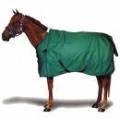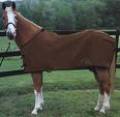
Horse Blankets Reviews
|
The Different Types Of Fly Sheets
The Different Types of Fly Sheets
Anyone who owns horses knows that fly are a problem. Even barns and horse owners with the tidiest stables, that haul their manure away immediately and have nice dry sandy lots have to deal with fly issues. Many horse owners attempt to control their fly population by using a variety of methods including fly sprays, fly strips, bug zappers, fly misters that mist the stabling area with fly sprays, and a variety of wraps and collars that have been soaked in fly spray. Mustangs will search for mud holes that they use to cover themselves in mud to discourage fly bites. In an effort to keep their horses bite free some owners try to keep them blanketed from head to toe, but hot summer temperatures often force them to removed the blankets during the hottest hours of the afternoon.
Several horse owners use fly sheets as a form of fly control.
The material used to make fly sheets is the same type of finely woven mesh material used
to make vinyl lawn furniture. The same type that has been used since the 1960's. Fly sheets are typically constructed of polyvinyl that is resistant to UV rays and comes in a wide variety of colors (including blaze orange for horse owner that live in the middle of a hunting region.) The polyvinyl is normally designed in a loose weave pattern. Polyvinyl is damage caused by dirt and oils.
Horse owners have two different types of fly sheets to select from, a scrim sheet and a turnout fly sheet.
Fly sheets that are designed for turnout purposes are typically made of a stiffer lightweight material then scrim fly sheets. When outfitting a horse with a turnout fly sheet owners should make sure that the sheet fits well enough that the breast straps, surcingles, and leg straps do not have to be tightened excessively which can impede the horses movement. Owners should not cross the leg straps of a turnout fly sheet. Leaving the leg straps uncrossed will allow the horse to flap his under his belly without ensnaring it in the straps. When purchasing a fly sheet for turnout owners should look for one made of a lightweight mesh material that is easy to clean. In the event of severe stains (manure and grass are the most common) blanket owners can try using a stiff, sudsy brush directly on the stain. this works especially well if the blanket is laid on a concrete surface. A fly sheet made with polyvinyl will typically dry within thirty minutes of being washed. Machine washable is ideal. It is not a bad idea to purchase two turnout fly sheets, that way if one gets dirty or tears owners have another one available.
A well crafted turnout fly sheet will be designed to tear if the horse gets it caught on something but should be designed in such a way that the damage will be minimal.
Most horse owners prefer elastic leg straps on their turnout fly sheets over the nylons variety.
Scrim flysheets are designed to be used while the horse is in a stall, typically after a thorough grooming has removed all the naturally protective dirt and oils from the horses coat. Scrim fly sheets are designed to loosely cover the horses body. because of the loose fit horses should never be turned loose while clothed in a scrim fly sheet. Many owners also use scrim fly sheets as an anti-sweat blanket.
The mesh design of fly sheets will not prevent the horse from becoming dirty and dusty like solid blankets.
A fly sheet should help wick moisture away from the horses body which will keep them cool and comfortable throughout the hot summer months.
 |
 |
 |
Do You Show Your Horse Love In The Winter
The Various Types Of Horse And Blankets And Sheets
Caring For A Pony During The Winter
Are Horse Blankets Really Necessary
More Horse Blankets Articles
... canvas has been used in the making of horse blankets, to further protect from the weather and also help lengthen the life of the blanket. If you are using your animal as a show horse, you might want to provide a saddle with a blanket in matching colors, maybe you'll want your initials on the blanket for ...
When Do You Need Horse Equipment
... mind who are better off not mentioned! But for the most part, horse ownership can be a welcome adventure. So can the process of getting the perfect horse equipment. Again--don't forget the horse blanket! Horses don't require much clothing, as anyone knows. But a horse blanket could be considered their ...
... ages, although excessive wear will merit replacement for your horse's benefit. A torn or holey blanket is sure to have less ability to do what it is meant to do. The horse blanket is a staple for the hard-core cowboy or frequent rider. It is a help to ranch hands when they have to stay out in the weather ...
Why Horse Blankets Are Handy With Splints
... the right food, clean water, adequate housing and roaming room, a horse brush, treats, careful training, and lots of love and attention? You need veterinary care. One of the things a horse can encounter includes something called splints. There are splint bones, not to be confused with the injury itself; ...

|
| Copyright © 2006-2012 Internet Marketing Tools, All Rights Reserved |